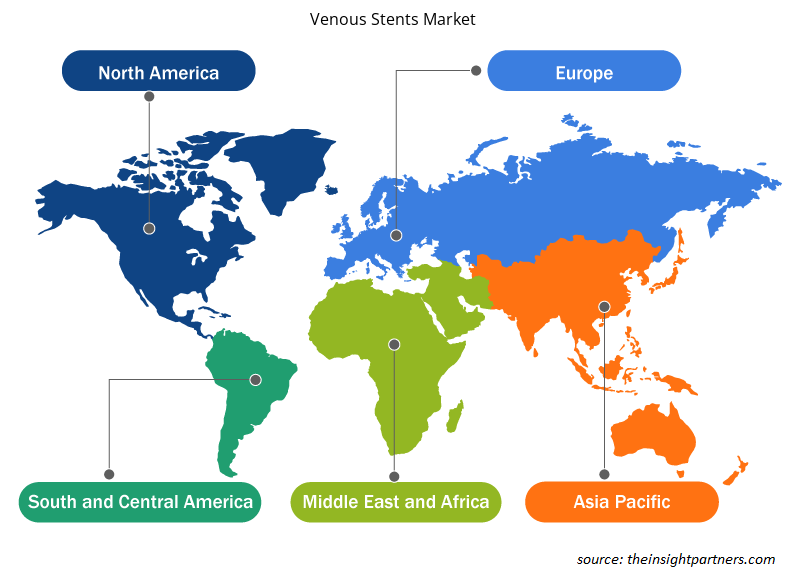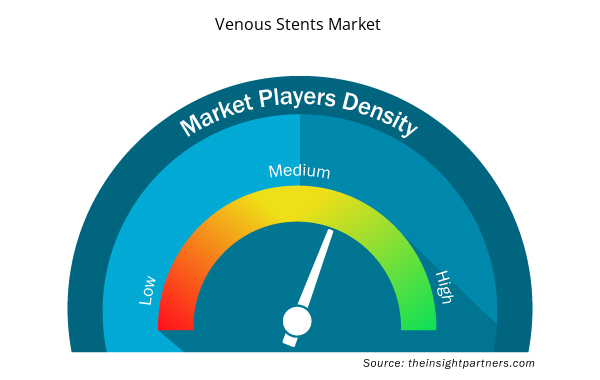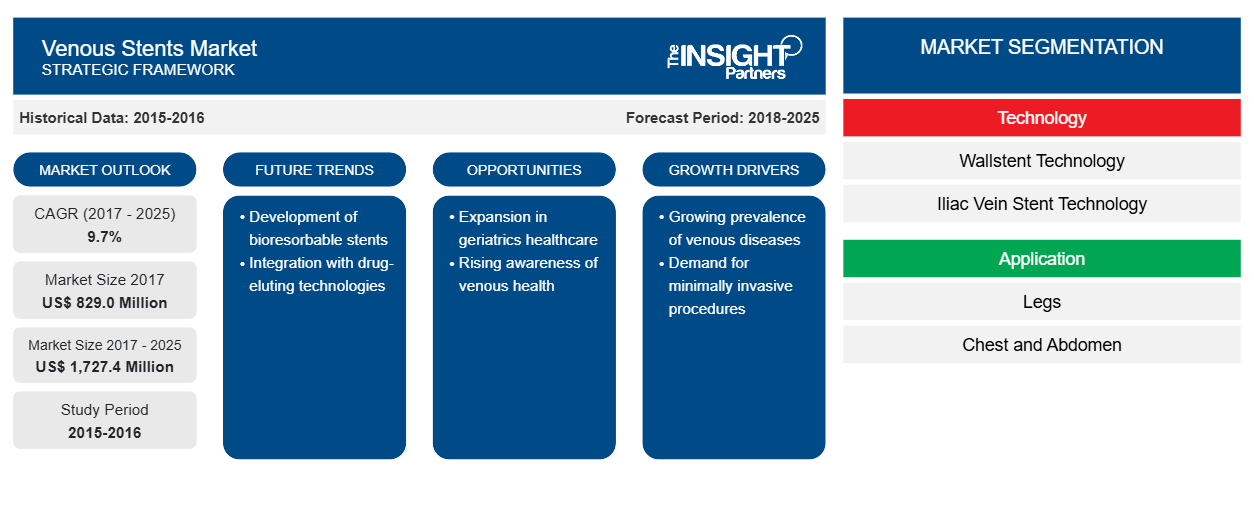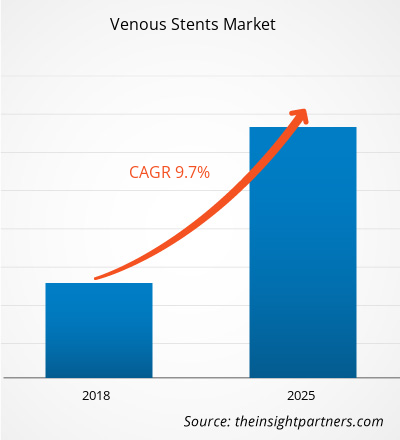[調査レポート] ヘルスケア市場における静脈ステントの市場規模は、2017年に8億2,900万米ドルと評価され、2025年までに17億2,740万米ドルに達すると予測されています。また、2018年から2025年にかけて9.7%のCAGRで成長すると予想されています。
静脈ステントは、閉塞した静脈や狭くなった静脈に対して拡張する金属でできたメッシュチューブです。これらのステントは、静脈壁を開いたままに保つのに役立つ足場の役割を果たします。静脈ステントは通常、脚、胸部、腹部にある中心静脈に配置されます。静脈ステントは、慢性深部静脈血栓症(DVT)、血栓後症候群などの症状の治療に使用されます。ヘルスケア市場における静脈ステントの成長は、静脈疾患の増加に起因しており、ステント技術の技術的進歩と老年人口の増加が市場の成長の主な原動力となっています。ただし、市場の成長は、承認に関する厳格な規制や外科手術の高コストなど、さまざまな要因によって抑制されています。
ヘルスケアにおける静脈ステント市場は、パンデミック後に大幅な成長が見込まれています。 ヘルスケアにおける静脈ステント市場は、パンデミック後に大幅な成長が見込まれています。 COVID-19は、ロックダウン、渡航禁止、事業閉鎖により、さまざまな国の経済や産業に影響を及ぼしています。 COVID-19危機は多くの国の公衆衛生システムに過度の負担をかけ、医療システムへの持続可能な投資の必要性を浮き彫りにしました。 COVID-19パンデミックが進行するにつれて、ヘルスケア業界の成長は低下すると予想されます。 ライフサイエンスセグメントは、体外診断製品の需要増加と世界的な研究開発活動の増加により繁栄しています。 しかし、医療技術およびイメージングセグメントは、実施される手術数の減少と機器調達の遅延または長期化により、売上が減少しています。 さらに、医療専門家によるバーチャルコンサルテーションは、パンデミック後の主流のケア提供モデルになると予想されています。 遠隔医療がケアの提供を変革するにつれて、デジタルヘルスは今後数年間繁栄し続けるでしょう。さらに、臨床試験の中断とそれに伴う医薬品の発売の遅れにより、将来的には完全にバーチャルな試験が行われるようになることも予想されます。mRNA などの新しい技術が登場し、製薬業界や市場を変革することが予想され、今後数年間で垂直統合や合弁事業がさらに進むことも予想されます。
要件に合わせてレポートをカスタマイズする
このレポートの一部、国レベルの分析、Excelデータパックなど、あらゆるレポートを無料でカスタマイズできます。また、スタートアップや大学向けのお得なオファーや割引もご利用いただけます。
- このレポートの主要な市場動向を入手してください。この無料サンプルには、市場動向から見積もりや予測に至るまでのデータ分析が含まれます。
市場分析
ヘルスケアにおける静脈ステントの用途拡大がヘルスケアにおける静脈ステント市場の成長を促進
静脈にダメージを与える症状は静脈疾患と呼ばれます。一般的な静脈疾患には、静脈血栓症、深部静脈血栓症、静脈うっ滞、静脈潰瘍、動静脈瘻、血栓後症候群、血栓性静脈炎などがあります。ジョンズ ホプキンス大学によると、米国人口の約 15% が静脈瘤を患っています。また、疾病管理予防センターによると、米国では毎年約 900,000 人 (1,000 人中 1 - 2 人) が深部静脈血栓症 (DVT) に罹患しています。また、DVT 患者の 33% が 10 年以内に DVT を再発するとも言われています。さらに、血栓性素因は血栓形成につながる素因です。血栓形成素因は遺伝的要因から生じ、遺伝性血栓素因はアンチトロンビンやプロテイン C などの遺伝因子が欠乏すると生じます。米国疾病管理予防センターは、米国の 5 ~ 8% の人が遺伝性血栓素因を持っていると推定しています。
地域やさまざまな国で静脈疾患の症例が増加しているため、静脈疾患の治療のための静脈ステントの必要性と需要が高まり、今後数年間の市場成長が促進されます。
ステント技術の進歩は、静脈ステントの市場も同様に拡大しています。多くの業界関係者が、ここ数年で革新的なタイプの静脈ステントを考案しました。静脈ステント手術の欠陥や技術的欠点が、新しいニチノール ステントの革命につながりました。たとえば、2018 年 1 月、メドトロニック社は、静脈自己拡張ステント システムである Abre の治験機器免除 (IDE) 研究の開始を発表しました。新しい Abre ステントは、腸骨大腿静脈に永久的にインプラントするために開発されました。Abre ステントを配置すると、ステントは強度と柔軟性の最適なバランスを提供し、外向きの力を発揮して静脈を開きます。同様に、2016 年 11 月、Cook Medical 社は、症状のある腸骨大腿静脈流出路閉塞の治療に使用される Zilver Vena 静脈ステントの安全性と有効性を評価する VIVO 臨床試験の開始を発表しました。このように、多くの企業が静脈製品ポートフォリオを拡大し、静脈疾患の治療のための包括的なポートフォリオを提供しています。
静脈ステントの進歩により、静脈疾患の治療は容易かつ正確になりました。これらの技術の進歩により、近い将来に市場が拡大する可能性があります。
深部静脈血栓症(DVT)と肺塞栓症(PE)の発生率は、男女ともに加齢とともに増加します。これは、血栓因子の加齢に伴う変化と大静脈弁の緩みによるものです。NHS財団によると、深部静脈血栓症または肺塞栓症の症例の90~95%は40歳以上の人に発生しています。さらに、がん、手術または固定、経静脈ペースメーカー、中心静脈カテーテル、感染症、腎臓病、血栓性素因、神経疾患による下肢麻痺などの慢性疾患は高齢者に多く見られ、これらすべての疾患は静脈血栓塞栓症の独立した予測因子です。
世界中で高齢者人口が増加しており、どの国でも高齢者人口の増加が見られます。国連の「世界人口予測 2017」のデータによると、世界では 60 歳以上の人口が 9 億 6,200 万人で、2050 年までに 21 億人、2100 年までに 31 億人に達すると予想されています。また、ヨーロッパは高齢者人口の約 25% を占め、最も大きな割合を占めています。したがって、高齢者人口の増加により、静脈ステントの用途が増加し、最終的には市場の成長に有利に働きます。
テクノロジーに基づく洞察
技術面では、ヘルスケア市場における静脈ステントは、ウォールステント技術と腸骨静脈ステント技術に分類されます。2017 年には、腸骨静脈ステント技術セグメントが技術別静脈ステントの 73.9% という最大の市場シェアを占めました。
アプリケーションベースの洞察
用途に基づいて、ヘルスケア市場における静脈ステントは、脚、胸部、腹部に区分されます。脚セグメントは、予測期間中に 9.6% の CAGR で成長すると予想されます。脚セグメントの成長は、主に高齢者人口における深部静脈血栓症の発生数の増加によって推進されています。
疾患に基づく洞察
疾患別に見ると、ヘルスケアにおける静脈ステント市場は、血栓後症候群、慢性深部静脈血栓症、メイ・サーナー症候群、血液透析/動静脈瘻、その他に分類されます。2017年には、慢性深部静脈血栓症セグメントが、疾患別の静脈ステント市場シェアの30.4%を占め、最大のシェアを占めました。
ヘルスケア市場の静脈ステントのプレーヤーは、世界中の変化する顧客の需要に応えるために製品の発売と拡大の戦略を採用しており、これにより世界的にブランド名を維持することも可能になります。
静脈ステント市場の地域別分析
予測期間を通じて静脈ステント市場に影響を与える地域的な傾向と要因は、Insight Partners のアナリストによって徹底的に説明されています。このセクションでは、北米、ヨーロッパ、アジア太平洋、中東、アフリカ、南米、中米にわたる静脈ステント市場のセグメントと地理についても説明します。

- 静脈ステント市場の地域別データを入手
静脈ステント市場レポートの範囲
| レポート属性 | 詳細 |
|---|---|
| 2017年の市場規模 | 8億2,900万米ドル |
| 2025年までの市場規模 | 17億2,740万米ドル |
| 世界のCAGR(2017年 - 2025年) | 9.7% |
| 履歴データ | 2015-2016 |
| 予測期間 | 2018-2025 |
| 対象セグメント | テクノロジー別
|
| 対象地域と国 | 北米
|
| 市場リーダーと主要企業プロフィール |
|
静脈ステント市場のプレーヤー密度:ビジネスダイナミクスへの影響を理解する
静脈ステント市場は、消費者の嗜好の変化、技術の進歩、製品の利点に対する認識の高まりなどの要因により、エンドユーザーの需要が高まり、急速に成長しています。需要が高まるにつれて、企業は提供を拡大し、消費者のニーズを満たすために革新し、新たなトレンドを活用し、市場の成長をさらに促進しています。
市場プレーヤー密度とは、特定の市場または業界内で活動している企業または会社の分布を指します。これは、特定の市場スペースに、その市場規模または総市場価値に対してどれだけの競合相手 (市場プレーヤー) が存在するかを示します。
静脈ステント市場で事業を展開している主要企業は次のとおりです。
- ボストン・サイエンティフィック・コーポレーション
- C. R バード (BD が買収)
- Jotech GMBH(Cryolife, Inc. が買収)
- 料理する
- WL ゴア アンド アソシエイツ
免責事項:上記の企業は、特定の順序でランク付けされていません。

- 静脈ステント市場のトップキープレーヤーの概要を入手
ヘルスケア市場における静脈ステント - テクノロジー別
- ウォールステントテクノロジー、
- 腸骨静脈ステント技術
ヘルスケア市場における静脈ステント – 用途別
- 脚
- 胸
- 腹部
ヘルスケア市場における静脈ステント – 疾患別
- 血栓後症候群、
- 慢性深部静脈血栓症、
- メイ・トゥルナー症候群、
- 血液透析/動静脈瘻、および
- その他
ヘルスケア市場における静脈ステント – 地域別
北米
- 私たち
- カナダ
- メキシコ
ヨーロッパ
- フランス
- ドイツ
- イタリア
- 英国
- スペイン
- その他のヨーロッパ
アジア太平洋(APAC)
- 中国
- インド
- 韓国
- 日本
- オーストラリア
- その他のアジア太平洋地域
中東・アフリカ(MEA)
- 南アフリカ
- サウジアラビア
- アラブ首長国連邦
- MEAの残り
南米と中央アメリカ(SCAM)
- ブラジル
- アルゼンチン
- 残りの詐欺
企業プロフィール
- ボストン・サイエンティフィック・コーポレーション
- C. R バード (BD が買収)
- Jotech GMBH(Cryolife, Inc. が買収)
- 料理する
- WL ゴア アンド アソシエイツ
- Optimed Medizinische Instrumente GMBH
- メドトロニック
- メディカドイツ GMBH & Co. KG
- コーディス
- 過去2年間の分析、基準年、CAGRによる予測(7年間)
- PEST分析とSWOT分析
- 市場規模価値/数量 - 世界、地域、国
- 業界と競争環境
- Excel データセット



Report Coverage
Revenue forecast, Company Analysis, Industry landscape, Growth factors, and Trends

Segment Covered
This text is related
to segments covered.

Regional Scope
North America, Europe, Asia Pacific, Middle East & Africa, South & Central America

Country Scope
This text is related
to country scope.
Trends and growth analysis reports related to Life Sciences : READ MORE..
The List of Companies
- Boston Scientific Corporation
- C. R Bard (acquired by BD)
- Jotech GMBH (acquired by Cryolife, Inc.)
- Cook
- W.L Gore & Associates
- Optimed Medizinische Instrumente GMBH
- Medtronic
- Medica Germany GMBH & Co. KG
- Cordis (acquired by Cardinal Health)
The Insight Partners performs research in 4 major stages: Data Collection & Secondary Research, Primary Research, Data Analysis and Data Triangulation & Final Review.
- Data Collection and Secondary Research:
As a market research and consulting firm operating from a decade, we have published and advised several client across the globe. First step for any study will start with an assessment of currently available data and insights from existing reports. Further, historical and current market information is collected from Investor Presentations, Annual Reports, SEC Filings, etc., and other information related to company’s performance and market positioning are gathered from Paid Databases (Factiva, Hoovers, and Reuters) and various other publications available in public domain.
Several associations trade associates, technical forums, institutes, societies and organization are accessed to gain technical as well as market related insights through their publications such as research papers, blogs and press releases related to the studies are referred to get cues about the market. Further, white papers, journals, magazines, and other news articles published in last 3 years are scrutinized and analyzed to understand the current market trends.
- Primary Research:
The primarily interview analysis comprise of data obtained from industry participants interview and answers to survey questions gathered by in-house primary team.
For primary research, interviews are conducted with industry experts/CEOs/Marketing Managers/VPs/Subject Matter Experts from both demand and supply side to get a 360-degree view of the market. The primary team conducts several interviews based on the complexity of the markets to understand the various market trends and dynamics which makes research more credible and precise.
A typical research interview fulfils the following functions:
- Provides first-hand information on the market size, market trends, growth trends, competitive landscape, and outlook
- Validates and strengthens in-house secondary research findings
- Develops the analysis team’s expertise and market understanding
Primary research involves email interactions and telephone interviews for each market, category, segment, and sub-segment across geographies. The participants who typically take part in such a process include, but are not limited to:
- Industry participants: VPs, business development managers, market intelligence managers and national sales managers
- Outside experts: Valuation experts, research analysts and key opinion leaders specializing in the electronics and semiconductor industry.
Below is the breakup of our primary respondents by company, designation, and region:

Once we receive the confirmation from primary research sources or primary respondents, we finalize the base year market estimation and forecast the data as per the macroeconomic and microeconomic factors assessed during data collection.
- Data Analysis:
Once data is validated through both secondary as well as primary respondents, we finalize the market estimations by hypothesis formulation and factor analysis at regional and country level.
- Macro-Economic Factor Analysis:
We analyse macroeconomic indicators such the gross domestic product (GDP), increase in the demand for goods and services across industries, technological advancement, regional economic growth, governmental policies, the influence of COVID-19, PEST analysis, and other aspects. This analysis aids in setting benchmarks for various nations/regions and approximating market splits. Additionally, the general trend of the aforementioned components aid in determining the market's development possibilities.
- Country Level Data:
Various factors that are especially aligned to the country are taken into account to determine the market size for a certain area and country, including the presence of vendors, such as headquarters and offices, the country's GDP, demand patterns, and industry growth. To comprehend the market dynamics for the nation, a number of growth variables, inhibitors, application areas, and current market trends are researched. The aforementioned elements aid in determining the country's overall market's growth potential.
- Company Profile:
The “Table of Contents” is formulated by listing and analyzing more than 25 - 30 companies operating in the market ecosystem across geographies. However, we profile only 10 companies as a standard practice in our syndicate reports. These 10 companies comprise leading, emerging, and regional players. Nonetheless, our analysis is not restricted to the 10 listed companies, we also analyze other companies present in the market to develop a holistic view and understand the prevailing trends. The “Company Profiles” section in the report covers key facts, business description, products & services, financial information, SWOT analysis, and key developments. The financial information presented is extracted from the annual reports and official documents of the publicly listed companies. Upon collecting the information for the sections of respective companies, we verify them via various primary sources and then compile the data in respective company profiles. The company level information helps us in deriving the base number as well as in forecasting the market size.
- Developing Base Number:
Aggregation of sales statistics (2020-2022) and macro-economic factor, and other secondary and primary research insights are utilized to arrive at base number and related market shares for 2022. The data gaps are identified in this step and relevant market data is analyzed, collected from paid primary interviews or databases. On finalizing the base year market size, forecasts are developed on the basis of macro-economic, industry and market growth factors and company level analysis.
- Data Triangulation and Final Review:
The market findings and base year market size calculations are validated from supply as well as demand side. Demand side validations are based on macro-economic factor analysis and benchmarks for respective regions and countries. In case of supply side validations, revenues of major companies are estimated (in case not available) based on industry benchmark, approximate number of employees, product portfolio, and primary interviews revenues are gathered. Further revenue from target product/service segment is assessed to avoid overshooting of market statistics. In case of heavy deviations between supply and demand side values, all thes steps are repeated to achieve synchronization.
We follow an iterative model, wherein we share our research findings with Subject Matter Experts (SME’s) and Key Opinion Leaders (KOLs) until consensus view of the market is not formulated – this model negates any drastic deviation in the opinions of experts. Only validated and universally acceptable research findings are quoted in our reports.
We have important check points that we use to validate our research findings – which we call – data triangulation, where we validate the information, we generate from secondary sources with primary interviews and then we re-validate with our internal data bases and Subject matter experts. This comprehensive model enables us to deliver high quality, reliable data in shortest possible time.


 このレポートの無料サンプルを入手する
このレポートの無料サンプルを入手する